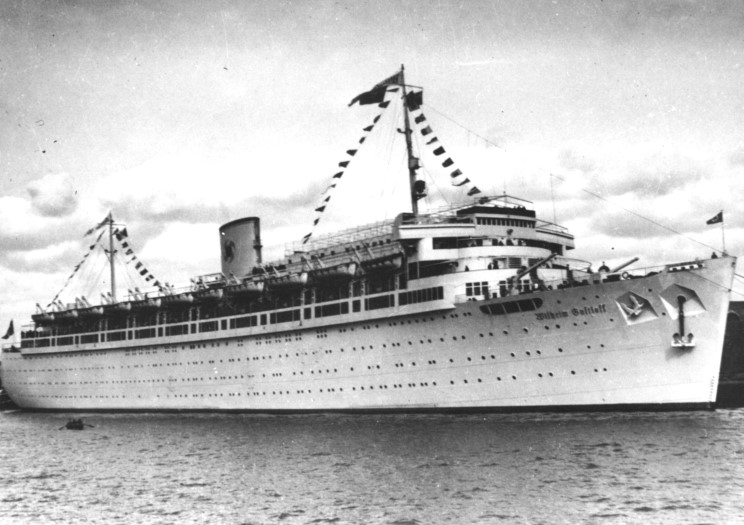|
January 30, 1945 the worst disaster in maritime history took place. While everyone knows the name Titanic, few can name the ship in which over six times more people died. On May 5, 1937 at the Blohm & Voss shipyard in Hamburg, Adolf Hitler launches his new propaganda ship. The KdF (Strength through Joy) ship was named in honor of the former leader of the Swiss Nazi party who had been assassinated in 1936, Wilhelm Gustloff. His widow was there and christened the ship. The KdF ships were designed to allow the common worker in Germany to afford the luxury of the wealthy. Treating people to first class cruising, but always under the watchful eye of the party. Cruising the Atlantic, Mediterranean and North Seas, it was hoped that treating the workers to such cruises would lull them into being more productive for the Reich. On April 4, 1938 the Gustloff rescued the 19 man crew of the British collier Pegway, which sank 20 miles off the Dutch island of Tershcelling. The propaganda ministry was quick to use this event to show unity even in the face of political differences. In April 1938 she was used as a floating polling station for Germans living in Britain. She took some 2,000 people from England, into international waters so they could vote on the annexation of Austria. In May of 1939 the Gustloff and five other ships, four of them KdF ships, transported German troops of the Condor Legion back from Spain. The Wilhelm Gustloff was commissioned into the Kriegsmarine on Sept. 22, 1939 as Lazarettschiff D. (Hospital ship D) Her first mission as a hospital ship was to transport wounded troops from the Polish campaign back to Germany. In May of 1940 the Gustloff was in Norway, once again transporting wounded from Oslo to Germany. In November of 1940 she was sent to Gotenhafen (Gdynia, Poland) to be used as a barracks ship for U-boat trainees. The Gustloff remained there until Jan. 30, 1945. In early January the largest evacuation in history was being planned by the Germans. Millions of Germans were fleeing from the advancing Russian armies. Dozens of ships, including the Gustloff were involved in the evacuation. On January 30, 1945 the Wilhelm Gustloff sailed from Gotenhafen (Gdynia, Poland) for Germany. The weather was poor to say the least. Snowing and 10 degrees below zero, she sailed with only one escort. She was spotted by the Soviet submarine S-13, commanded by 32 year old Alexander Marinesko. The S-13 shadowed the Gustloff for some time hoping she would steam into deeper water. However the Gustloff hugged the coast. Running with her lights on to avoid collisions with German minesweepers, the Gustloff was nothing more than a giant target. The problem for Marinesko was that the Gustloff was sailing in water only about 170' deep. The S-13 needed water 400' deep or more to safely attack the ship. However Marinesko decided to risk the attack anyway. Marinesko was not in good favor with the higher-ups in the Soviet navy and he felt he needed a victory to smooth things over with them. So he made a daring move. He wanted to attack from the shore side, so he dove the S-13 under the Gustloff with only a few feet to spare above or below, and positioned his sub for the kill. The S-13 crew loaded four torpedoes and around 21:00 hrs. fired them. One and two fired smoothly, but three jammed in the tube. The fourth torpedo was released without problem. The first torpedo struck the Gustloff near the bow. The second in the area of the swimming pool, where 400 members of the Women's Auxiliary of the German Navy had been placed. They were all killed. The third struck amidships forward of the engine room. This was the end of the Wilhelm Gustloff. Thousands of people now in the freezing water saw the enemy. The S-13 on the surface, the crew franticly trying to ram the stuck torpedo back into the tube. The survivors were sure the S-13 was going to machine gun them in the water, but it did not. The torpedo was finally pushed in, the outer door closed, the S-13 made her getaway. Several German ships came to the rescue and recovered over 1,000 survivors. However in the 50 minuets it took for this disaster to occur between 9,000 and 10,000 people died. Making this the worst disaster in maritime history. Alexander Marinesko and the S-13 went on to become the deadliest submarine in history. On February 10, 1945, they sunk the General Von Steuben, which was also being used to evacuate Germans from Poland. In this event around 4,000 people were killed. Marinesko however was not regarded as a hero by the Soviets. He was basically a maverick who the Soviets had no use for. In 1946 he was sent to a Gulag in Siberia for some supposed crime. When he was released his spirit and his body were broken. He lived on state welfare until his death in 1963 at the age of 50. In 1990 Marinesko, deemed by Hitler as "his personal enemy" was made "A Hero of the Soviet Union" posthumously of course. Before his death he was given his former rank back and a larger pension. He also lived long enough to see a documentary about him on state TV. There is now a memorial to him and a ship that bears his name, he is finally a hero in Russia. |
© 2006 Michael W. Pocock MaritimeQuest.com |
 |
Wilhelm Gustloff |